Student Portfolio: Android Development Reflective Journal Analysis
VerifiedAdded on 2020/03/16
|12
|3041
|75
Portfolio
AI Summary
This portfolio is an individual reflective journal documenting a student's learning journey through an Android app development course. The journal covers a range of topics, starting with the basics of Android application development, including activities, fragments, and lifecycle management. It then delves into UI design, exploring views, action bars, and user experience considerations. The journal progresses to cover data display, menus, data sharing methods, SMS, email messaging, location services, and networking concepts such as HTTP web services and JSON. Further topics include middleware web services, mobile application testing, and app store strategies. Each week's reflection provides insights into the key concepts learned, practical applications, and challenges faced, providing a comprehensive overview of the student's understanding and progress throughout the course. The document is available on Desklib, a platform offering past papers and solved assignments to help students with their studies.
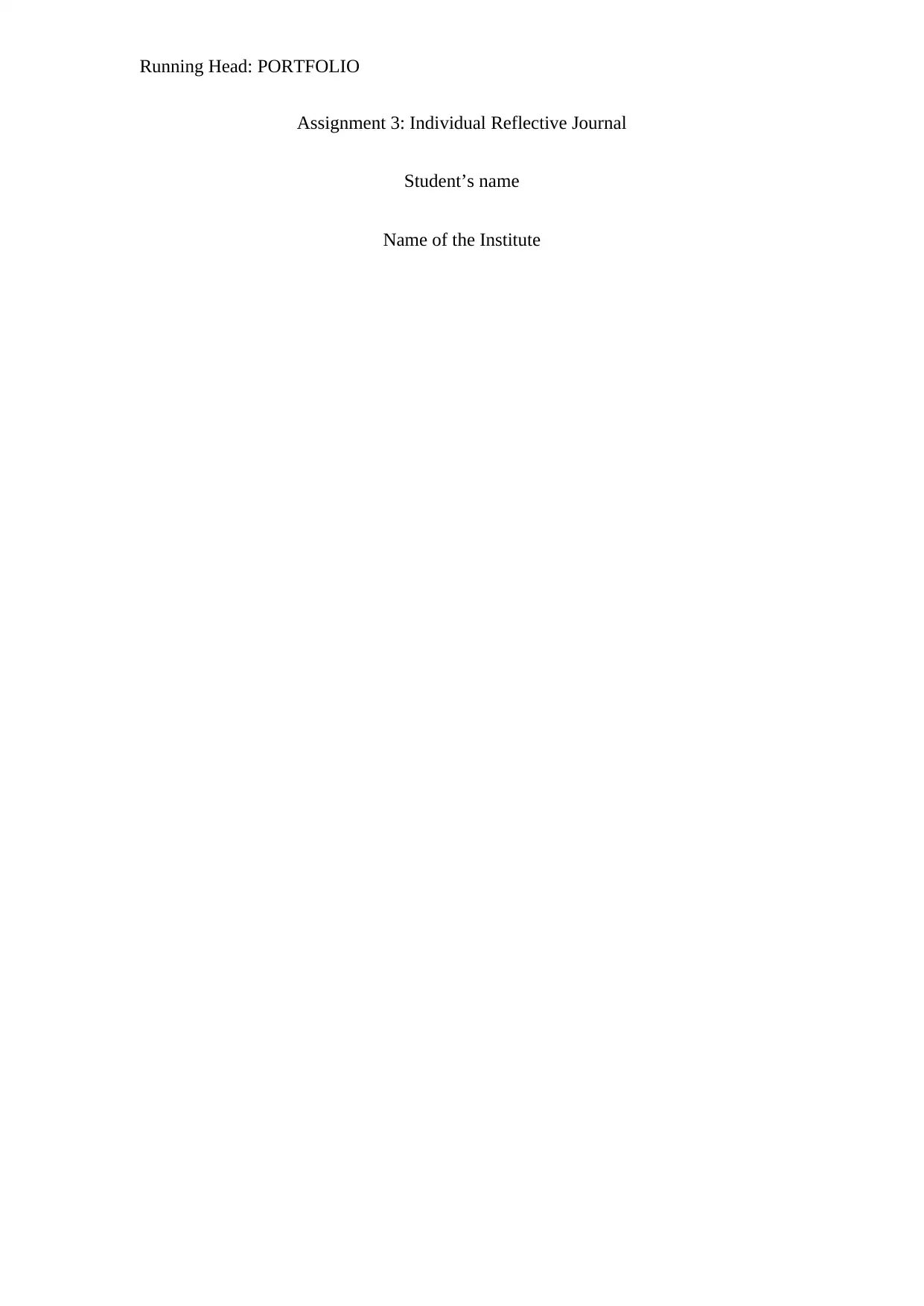
Running Head: PORTFOLIO
Assignment 3: Individual Reflective Journal
Student’s name
Name of the Institute
Assignment 3: Individual Reflective Journal
Student’s name
Name of the Institute
Paraphrase This Document
Need a fresh take? Get an instant paraphrase of this document with our AI Paraphraser
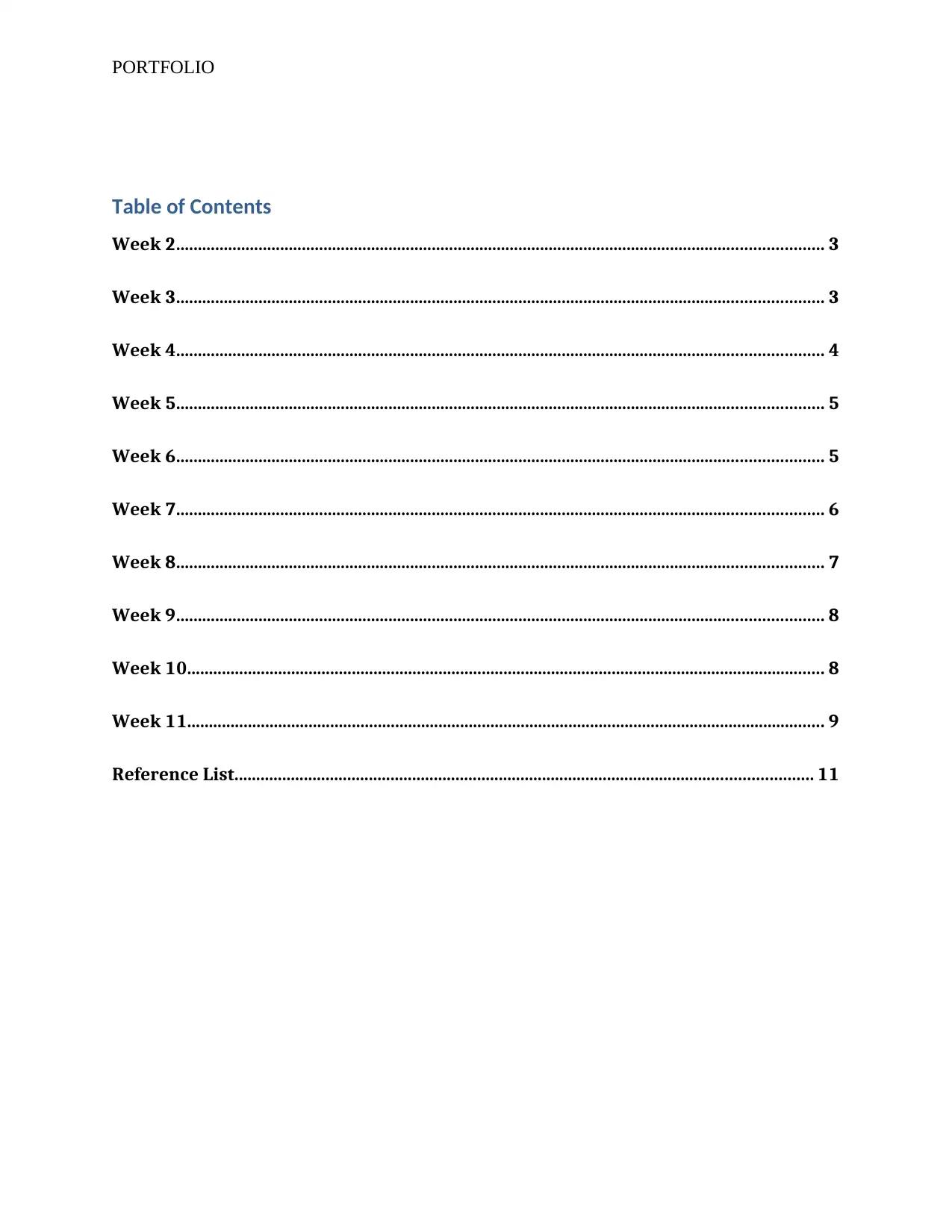
PORTFOLIO
Table of Contents
Week 2..................................................................................................................................................... 3
Week 3..................................................................................................................................................... 3
Week 4..................................................................................................................................................... 4
Week 5..................................................................................................................................................... 5
Week 6..................................................................................................................................................... 5
Week 7..................................................................................................................................................... 6
Week 8..................................................................................................................................................... 7
Week 9..................................................................................................................................................... 8
Week 10................................................................................................................................................... 8
Week 11................................................................................................................................................... 9
Reference List..................................................................................................................................... 11
Table of Contents
Week 2..................................................................................................................................................... 3
Week 3..................................................................................................................................................... 3
Week 4..................................................................................................................................................... 4
Week 5..................................................................................................................................................... 5
Week 6..................................................................................................................................................... 5
Week 7..................................................................................................................................................... 6
Week 8..................................................................................................................................................... 7
Week 9..................................................................................................................................................... 8
Week 10................................................................................................................................................... 8
Week 11................................................................................................................................................... 9
Reference List..................................................................................................................................... 11
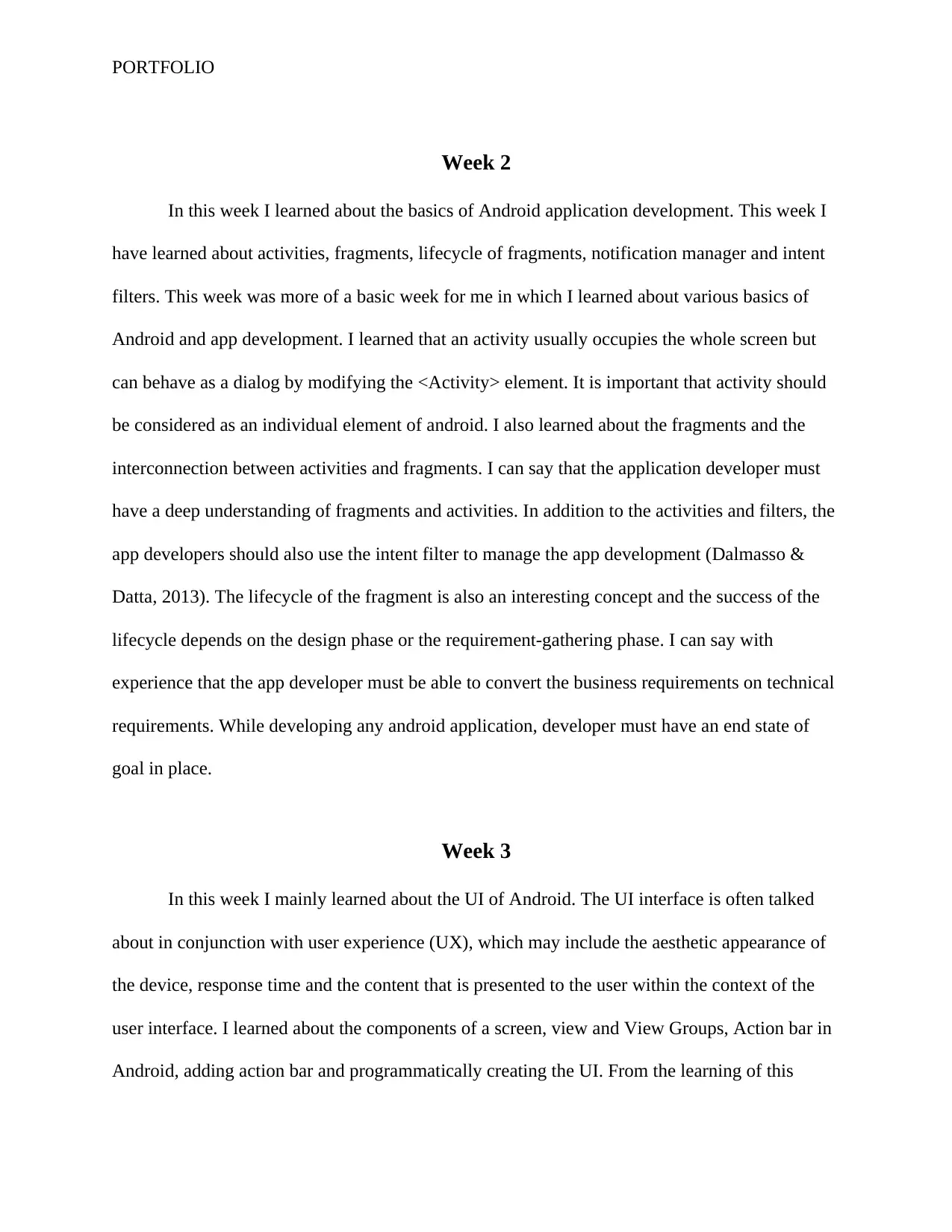
PORTFOLIO
Week 2
In this week I learned about the basics of Android application development. This week I
have learned about activities, fragments, lifecycle of fragments, notification manager and intent
filters. This week was more of a basic week for me in which I learned about various basics of
Android and app development. I learned that an activity usually occupies the whole screen but
can behave as a dialog by modifying the <Activity> element. It is important that activity should
be considered as an individual element of android. I also learned about the fragments and the
interconnection between activities and fragments. I can say that the application developer must
have a deep understanding of fragments and activities. In addition to the activities and filters, the
app developers should also use the intent filter to manage the app development (Dalmasso &
Datta, 2013). The lifecycle of the fragment is also an interesting concept and the success of the
lifecycle depends on the design phase or the requirement-gathering phase. I can say with
experience that the app developer must be able to convert the business requirements on technical
requirements. While developing any android application, developer must have an end state of
goal in place.
Week 3
In this week I mainly learned about the UI of Android. The UI interface is often talked
about in conjunction with user experience (UX), which may include the aesthetic appearance of
the device, response time and the content that is presented to the user within the context of the
user interface. I learned about the components of a screen, view and View Groups, Action bar in
Android, adding action bar and programmatically creating the UI. From the learning of this
Week 2
In this week I learned about the basics of Android application development. This week I
have learned about activities, fragments, lifecycle of fragments, notification manager and intent
filters. This week was more of a basic week for me in which I learned about various basics of
Android and app development. I learned that an activity usually occupies the whole screen but
can behave as a dialog by modifying the <Activity> element. It is important that activity should
be considered as an individual element of android. I also learned about the fragments and the
interconnection between activities and fragments. I can say that the application developer must
have a deep understanding of fragments and activities. In addition to the activities and filters, the
app developers should also use the intent filter to manage the app development (Dalmasso &
Datta, 2013). The lifecycle of the fragment is also an interesting concept and the success of the
lifecycle depends on the design phase or the requirement-gathering phase. I can say with
experience that the app developer must be able to convert the business requirements on technical
requirements. While developing any android application, developer must have an end state of
goal in place.
Week 3
In this week I mainly learned about the UI of Android. The UI interface is often talked
about in conjunction with user experience (UX), which may include the aesthetic appearance of
the device, response time and the content that is presented to the user within the context of the
user interface. I learned about the components of a screen, view and View Groups, Action bar in
Android, adding action bar and programmatically creating the UI. From the learning of this
⊘ This is a preview!⊘
Do you want full access?
Subscribe today to unlock all pages.

Trusted by 1+ million students worldwide
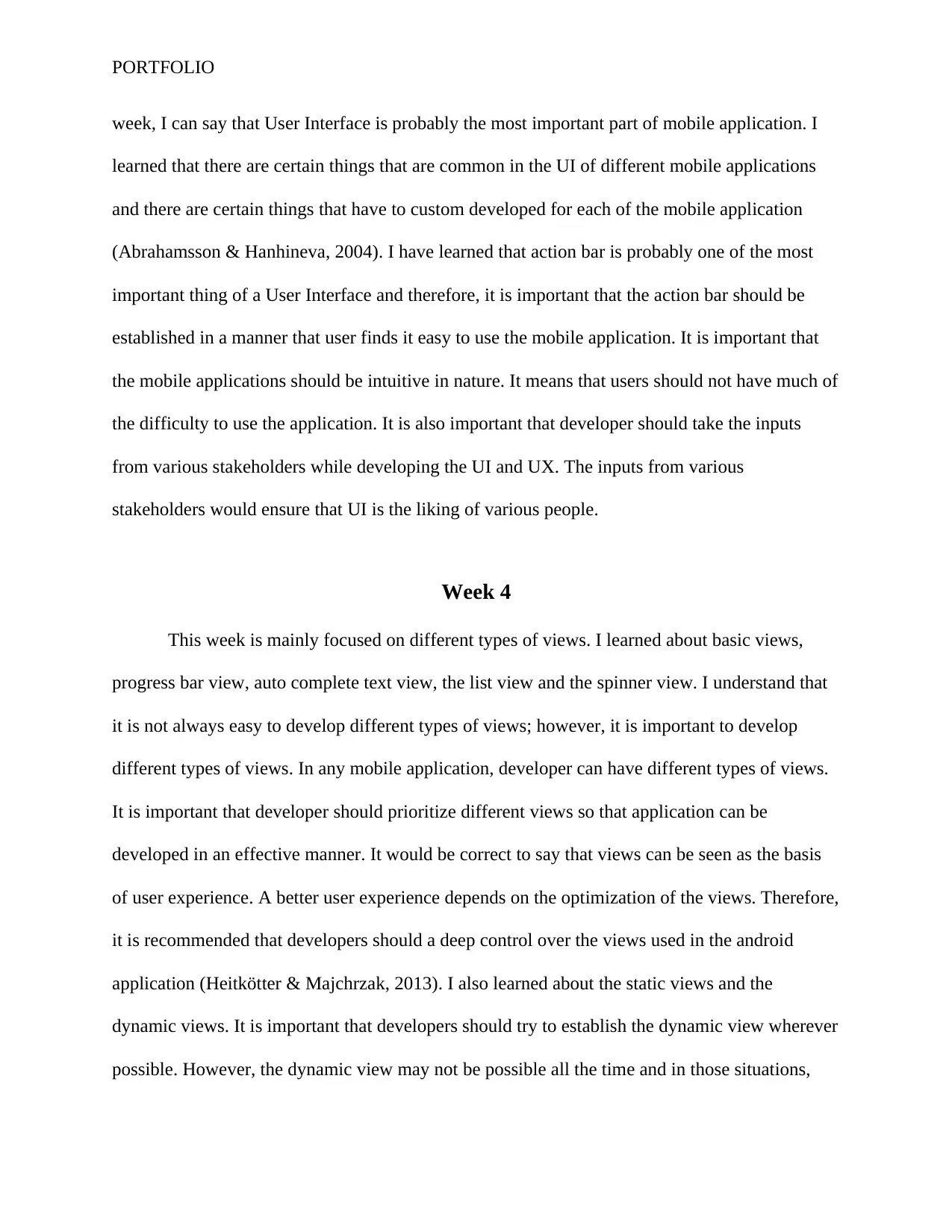
PORTFOLIO
week, I can say that User Interface is probably the most important part of mobile application. I
learned that there are certain things that are common in the UI of different mobile applications
and there are certain things that have to custom developed for each of the mobile application
(Abrahamsson & Hanhineva, 2004). I have learned that action bar is probably one of the most
important thing of a User Interface and therefore, it is important that the action bar should be
established in a manner that user finds it easy to use the mobile application. It is important that
the mobile applications should be intuitive in nature. It means that users should not have much of
the difficulty to use the application. It is also important that developer should take the inputs
from various stakeholders while developing the UI and UX. The inputs from various
stakeholders would ensure that UI is the liking of various people.
Week 4
This week is mainly focused on different types of views. I learned about basic views,
progress bar view, auto complete text view, the list view and the spinner view. I understand that
it is not always easy to develop different types of views; however, it is important to develop
different types of views. In any mobile application, developer can have different types of views.
It is important that developer should prioritize different views so that application can be
developed in an effective manner. It would be correct to say that views can be seen as the basis
of user experience. A better user experience depends on the optimization of the views. Therefore,
it is recommended that developers should a deep control over the views used in the android
application (Heitkötter & Majchrzak, 2013). I also learned about the static views and the
dynamic views. It is important that developers should try to establish the dynamic view wherever
possible. However, the dynamic view may not be possible all the time and in those situations,
week, I can say that User Interface is probably the most important part of mobile application. I
learned that there are certain things that are common in the UI of different mobile applications
and there are certain things that have to custom developed for each of the mobile application
(Abrahamsson & Hanhineva, 2004). I have learned that action bar is probably one of the most
important thing of a User Interface and therefore, it is important that the action bar should be
established in a manner that user finds it easy to use the mobile application. It is important that
the mobile applications should be intuitive in nature. It means that users should not have much of
the difficulty to use the application. It is also important that developer should take the inputs
from various stakeholders while developing the UI and UX. The inputs from various
stakeholders would ensure that UI is the liking of various people.
Week 4
This week is mainly focused on different types of views. I learned about basic views,
progress bar view, auto complete text view, the list view and the spinner view. I understand that
it is not always easy to develop different types of views; however, it is important to develop
different types of views. In any mobile application, developer can have different types of views.
It is important that developer should prioritize different views so that application can be
developed in an effective manner. It would be correct to say that views can be seen as the basis
of user experience. A better user experience depends on the optimization of the views. Therefore,
it is recommended that developers should a deep control over the views used in the android
application (Heitkötter & Majchrzak, 2013). I also learned about the static views and the
dynamic views. It is important that developers should try to establish the dynamic view wherever
possible. However, the dynamic view may not be possible all the time and in those situations,
Paraphrase This Document
Need a fresh take? Get an instant paraphrase of this document with our AI Paraphraser
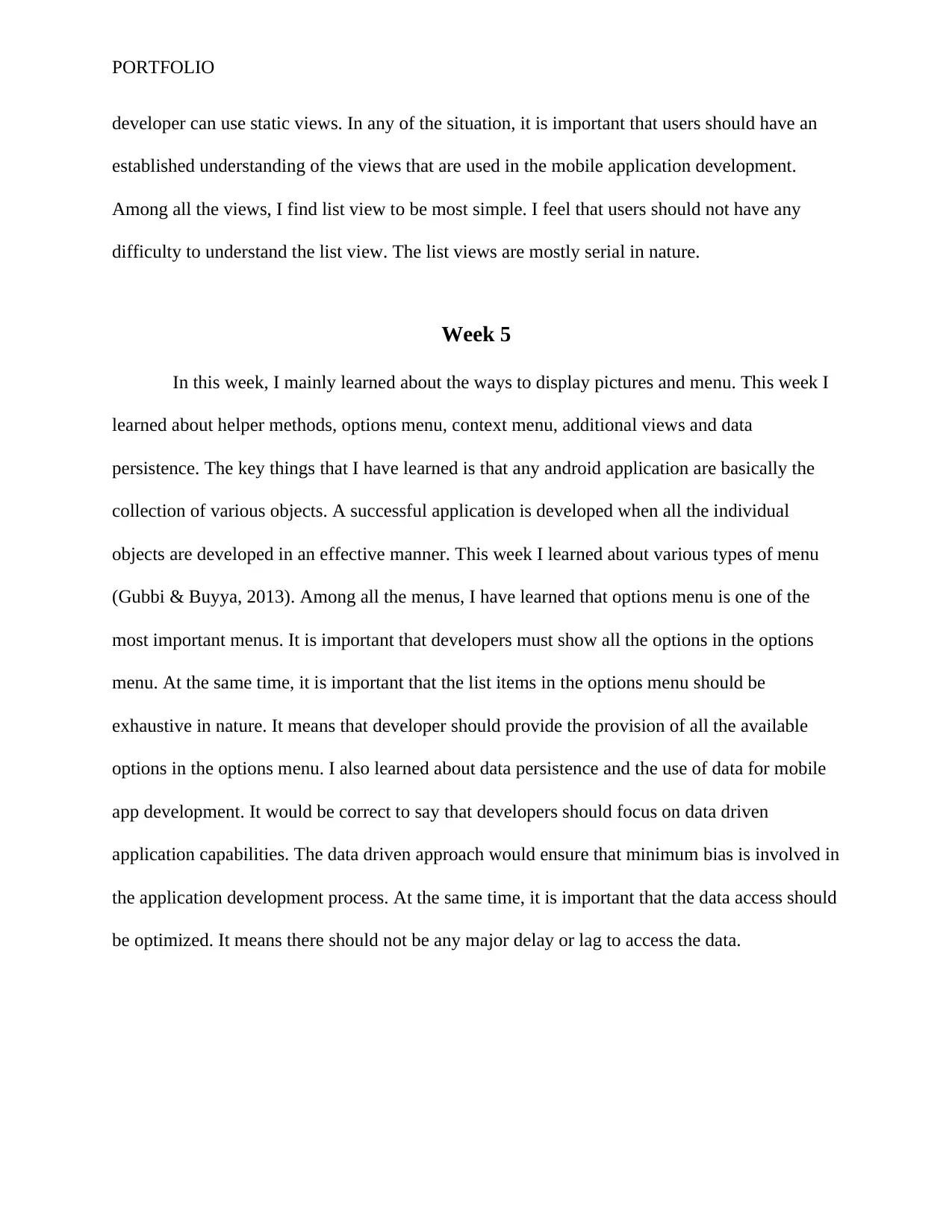
PORTFOLIO
developer can use static views. In any of the situation, it is important that users should have an
established understanding of the views that are used in the mobile application development.
Among all the views, I find list view to be most simple. I feel that users should not have any
difficulty to understand the list view. The list views are mostly serial in nature.
Week 5
In this week, I mainly learned about the ways to display pictures and menu. This week I
learned about helper methods, options menu, context menu, additional views and data
persistence. The key things that I have learned is that any android application are basically the
collection of various objects. A successful application is developed when all the individual
objects are developed in an effective manner. This week I learned about various types of menu
(Gubbi & Buyya, 2013). Among all the menus, I have learned that options menu is one of the
most important menus. It is important that developers must show all the options in the options
menu. At the same time, it is important that the list items in the options menu should be
exhaustive in nature. It means that developer should provide the provision of all the available
options in the options menu. I also learned about data persistence and the use of data for mobile
app development. It would be correct to say that developers should focus on data driven
application capabilities. The data driven approach would ensure that minimum bias is involved in
the application development process. At the same time, it is important that the data access should
be optimized. It means there should not be any major delay or lag to access the data.
developer can use static views. In any of the situation, it is important that users should have an
established understanding of the views that are used in the mobile application development.
Among all the views, I find list view to be most simple. I feel that users should not have any
difficulty to understand the list view. The list views are mostly serial in nature.
Week 5
In this week, I mainly learned about the ways to display pictures and menu. This week I
learned about helper methods, options menu, context menu, additional views and data
persistence. The key things that I have learned is that any android application are basically the
collection of various objects. A successful application is developed when all the individual
objects are developed in an effective manner. This week I learned about various types of menu
(Gubbi & Buyya, 2013). Among all the menus, I have learned that options menu is one of the
most important menus. It is important that developers must show all the options in the options
menu. At the same time, it is important that the list items in the options menu should be
exhaustive in nature. It means that developer should provide the provision of all the available
options in the options menu. I also learned about data persistence and the use of data for mobile
app development. It would be correct to say that developers should focus on data driven
application capabilities. The data driven approach would ensure that minimum bias is involved in
the application development process. At the same time, it is important that the data access should
be optimized. It means there should not be any major delay or lag to access the data.
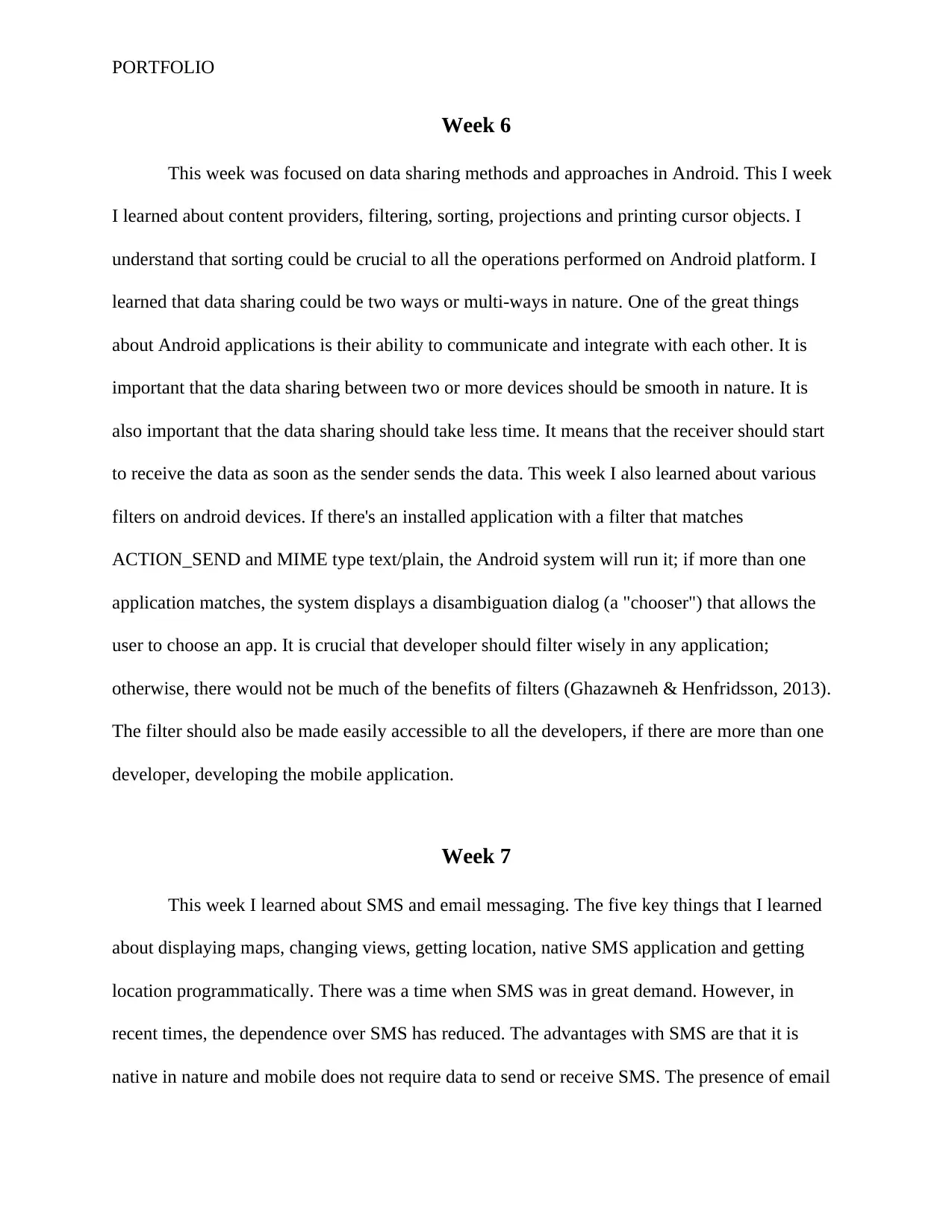
PORTFOLIO
Week 6
This week was focused on data sharing methods and approaches in Android. This I week
I learned about content providers, filtering, sorting, projections and printing cursor objects. I
understand that sorting could be crucial to all the operations performed on Android platform. I
learned that data sharing could be two ways or multi-ways in nature. One of the great things
about Android applications is their ability to communicate and integrate with each other. It is
important that the data sharing between two or more devices should be smooth in nature. It is
also important that the data sharing should take less time. It means that the receiver should start
to receive the data as soon as the sender sends the data. This week I also learned about various
filters on android devices. If there's an installed application with a filter that matches
ACTION_SEND and MIME type text/plain, the Android system will run it; if more than one
application matches, the system displays a disambiguation dialog (a "chooser") that allows the
user to choose an app. It is crucial that developer should filter wisely in any application;
otherwise, there would not be much of the benefits of filters (Ghazawneh & Henfridsson, 2013).
The filter should also be made easily accessible to all the developers, if there are more than one
developer, developing the mobile application.
Week 7
This week I learned about SMS and email messaging. The five key things that I learned
about displaying maps, changing views, getting location, native SMS application and getting
location programmatically. There was a time when SMS was in great demand. However, in
recent times, the dependence over SMS has reduced. The advantages with SMS are that it is
native in nature and mobile does not require data to send or receive SMS. The presence of email
Week 6
This week was focused on data sharing methods and approaches in Android. This I week
I learned about content providers, filtering, sorting, projections and printing cursor objects. I
understand that sorting could be crucial to all the operations performed on Android platform. I
learned that data sharing could be two ways or multi-ways in nature. One of the great things
about Android applications is their ability to communicate and integrate with each other. It is
important that the data sharing between two or more devices should be smooth in nature. It is
also important that the data sharing should take less time. It means that the receiver should start
to receive the data as soon as the sender sends the data. This week I also learned about various
filters on android devices. If there's an installed application with a filter that matches
ACTION_SEND and MIME type text/plain, the Android system will run it; if more than one
application matches, the system displays a disambiguation dialog (a "chooser") that allows the
user to choose an app. It is crucial that developer should filter wisely in any application;
otherwise, there would not be much of the benefits of filters (Ghazawneh & Henfridsson, 2013).
The filter should also be made easily accessible to all the developers, if there are more than one
developer, developing the mobile application.
Week 7
This week I learned about SMS and email messaging. The five key things that I learned
about displaying maps, changing views, getting location, native SMS application and getting
location programmatically. There was a time when SMS was in great demand. However, in
recent times, the dependence over SMS has reduced. The advantages with SMS are that it is
native in nature and mobile does not require data to send or receive SMS. The presence of email
⊘ This is a preview!⊘
Do you want full access?
Subscribe today to unlock all pages.

Trusted by 1+ million students worldwide
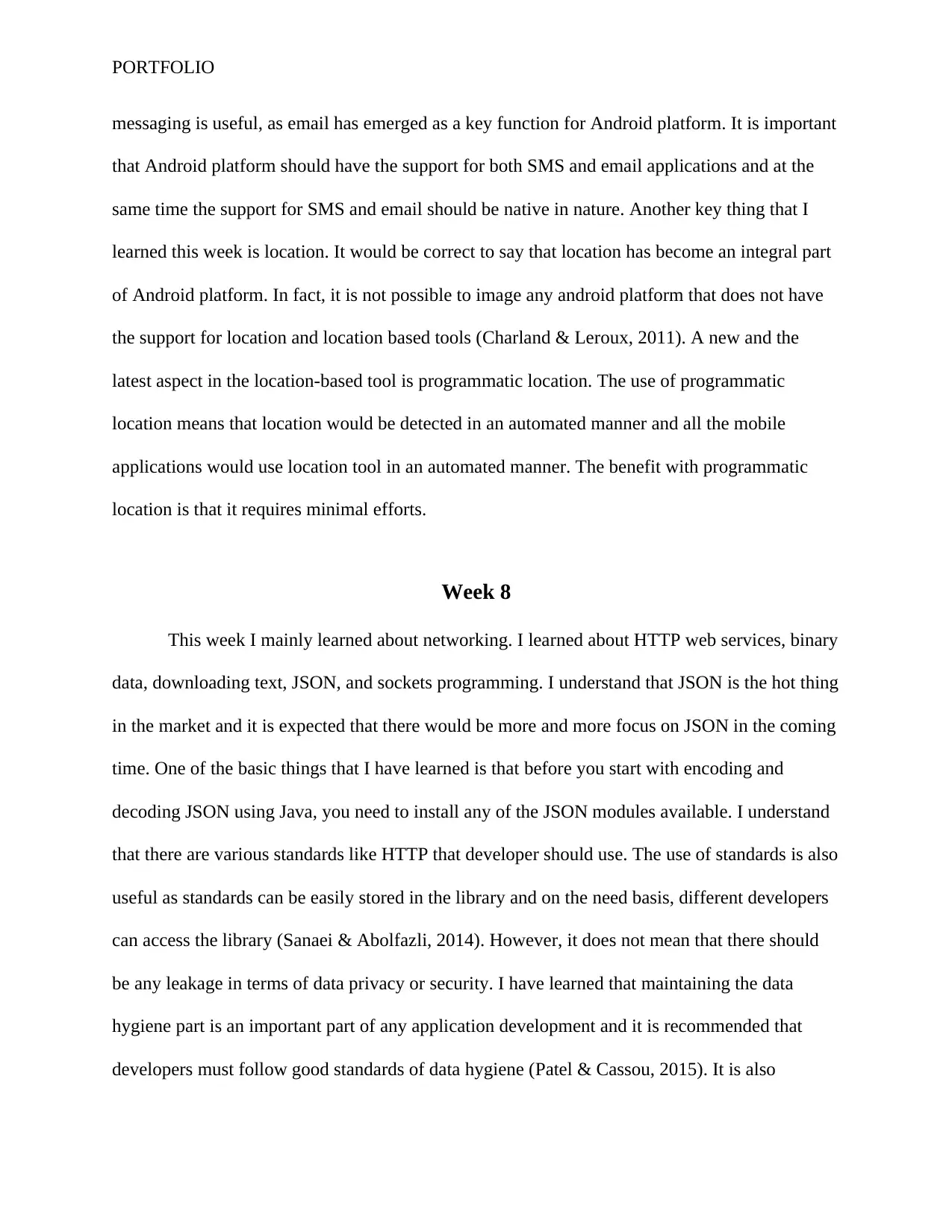
PORTFOLIO
messaging is useful, as email has emerged as a key function for Android platform. It is important
that Android platform should have the support for both SMS and email applications and at the
same time the support for SMS and email should be native in nature. Another key thing that I
learned this week is location. It would be correct to say that location has become an integral part
of Android platform. In fact, it is not possible to image any android platform that does not have
the support for location and location based tools (Charland & Leroux, 2011). A new and the
latest aspect in the location-based tool is programmatic location. The use of programmatic
location means that location would be detected in an automated manner and all the mobile
applications would use location tool in an automated manner. The benefit with programmatic
location is that it requires minimal efforts.
Week 8
This week I mainly learned about networking. I learned about HTTP web services, binary
data, downloading text, JSON, and sockets programming. I understand that JSON is the hot thing
in the market and it is expected that there would be more and more focus on JSON in the coming
time. One of the basic things that I have learned is that before you start with encoding and
decoding JSON using Java, you need to install any of the JSON modules available. I understand
that there are various standards like HTTP that developer should use. The use of standards is also
useful as standards can be easily stored in the library and on the need basis, different developers
can access the library (Sanaei & Abolfazli, 2014). However, it does not mean that there should
be any leakage in terms of data privacy or security. I have learned that maintaining the data
hygiene part is an important part of any application development and it is recommended that
developers must follow good standards of data hygiene (Patel & Cassou, 2015). It is also
messaging is useful, as email has emerged as a key function for Android platform. It is important
that Android platform should have the support for both SMS and email applications and at the
same time the support for SMS and email should be native in nature. Another key thing that I
learned this week is location. It would be correct to say that location has become an integral part
of Android platform. In fact, it is not possible to image any android platform that does not have
the support for location and location based tools (Charland & Leroux, 2011). A new and the
latest aspect in the location-based tool is programmatic location. The use of programmatic
location means that location would be detected in an automated manner and all the mobile
applications would use location tool in an automated manner. The benefit with programmatic
location is that it requires minimal efforts.
Week 8
This week I mainly learned about networking. I learned about HTTP web services, binary
data, downloading text, JSON, and sockets programming. I understand that JSON is the hot thing
in the market and it is expected that there would be more and more focus on JSON in the coming
time. One of the basic things that I have learned is that before you start with encoding and
decoding JSON using Java, you need to install any of the JSON modules available. I understand
that there are various standards like HTTP that developer should use. The use of standards is also
useful as standards can be easily stored in the library and on the need basis, different developers
can access the library (Sanaei & Abolfazli, 2014). However, it does not mean that there should
be any leakage in terms of data privacy or security. I have learned that maintaining the data
hygiene part is an important part of any application development and it is recommended that
developers must follow good standards of data hygiene (Patel & Cassou, 2015). It is also
Paraphrase This Document
Need a fresh take? Get an instant paraphrase of this document with our AI Paraphraser
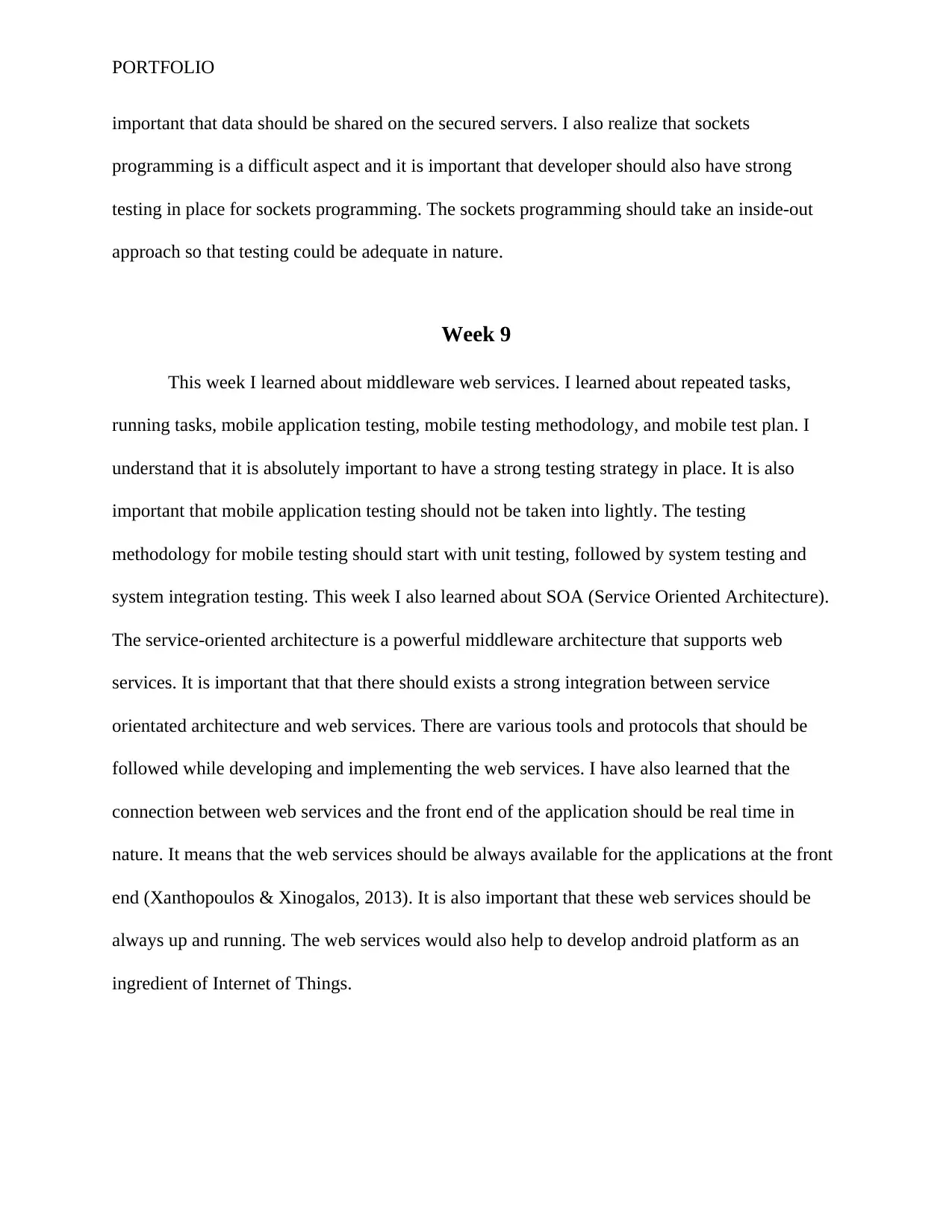
PORTFOLIO
important that data should be shared on the secured servers. I also realize that sockets
programming is a difficult aspect and it is important that developer should also have strong
testing in place for sockets programming. The sockets programming should take an inside-out
approach so that testing could be adequate in nature.
Week 9
This week I learned about middleware web services. I learned about repeated tasks,
running tasks, mobile application testing, mobile testing methodology, and mobile test plan. I
understand that it is absolutely important to have a strong testing strategy in place. It is also
important that mobile application testing should not be taken into lightly. The testing
methodology for mobile testing should start with unit testing, followed by system testing and
system integration testing. This week I also learned about SOA (Service Oriented Architecture).
The service-oriented architecture is a powerful middleware architecture that supports web
services. It is important that that there should exists a strong integration between service
orientated architecture and web services. There are various tools and protocols that should be
followed while developing and implementing the web services. I have also learned that the
connection between web services and the front end of the application should be real time in
nature. It means that the web services should be always available for the applications at the front
end (Xanthopoulos & Xinogalos, 2013). It is also important that these web services should be
always up and running. The web services would also help to develop android platform as an
ingredient of Internet of Things.
important that data should be shared on the secured servers. I also realize that sockets
programming is a difficult aspect and it is important that developer should also have strong
testing in place for sockets programming. The sockets programming should take an inside-out
approach so that testing could be adequate in nature.
Week 9
This week I learned about middleware web services. I learned about repeated tasks,
running tasks, mobile application testing, mobile testing methodology, and mobile test plan. I
understand that it is absolutely important to have a strong testing strategy in place. It is also
important that mobile application testing should not be taken into lightly. The testing
methodology for mobile testing should start with unit testing, followed by system testing and
system integration testing. This week I also learned about SOA (Service Oriented Architecture).
The service-oriented architecture is a powerful middleware architecture that supports web
services. It is important that that there should exists a strong integration between service
orientated architecture and web services. There are various tools and protocols that should be
followed while developing and implementing the web services. I have also learned that the
connection between web services and the front end of the application should be real time in
nature. It means that the web services should be always available for the applications at the front
end (Xanthopoulos & Xinogalos, 2013). It is also important that these web services should be
always up and running. The web services would also help to develop android platform as an
ingredient of Internet of Things.
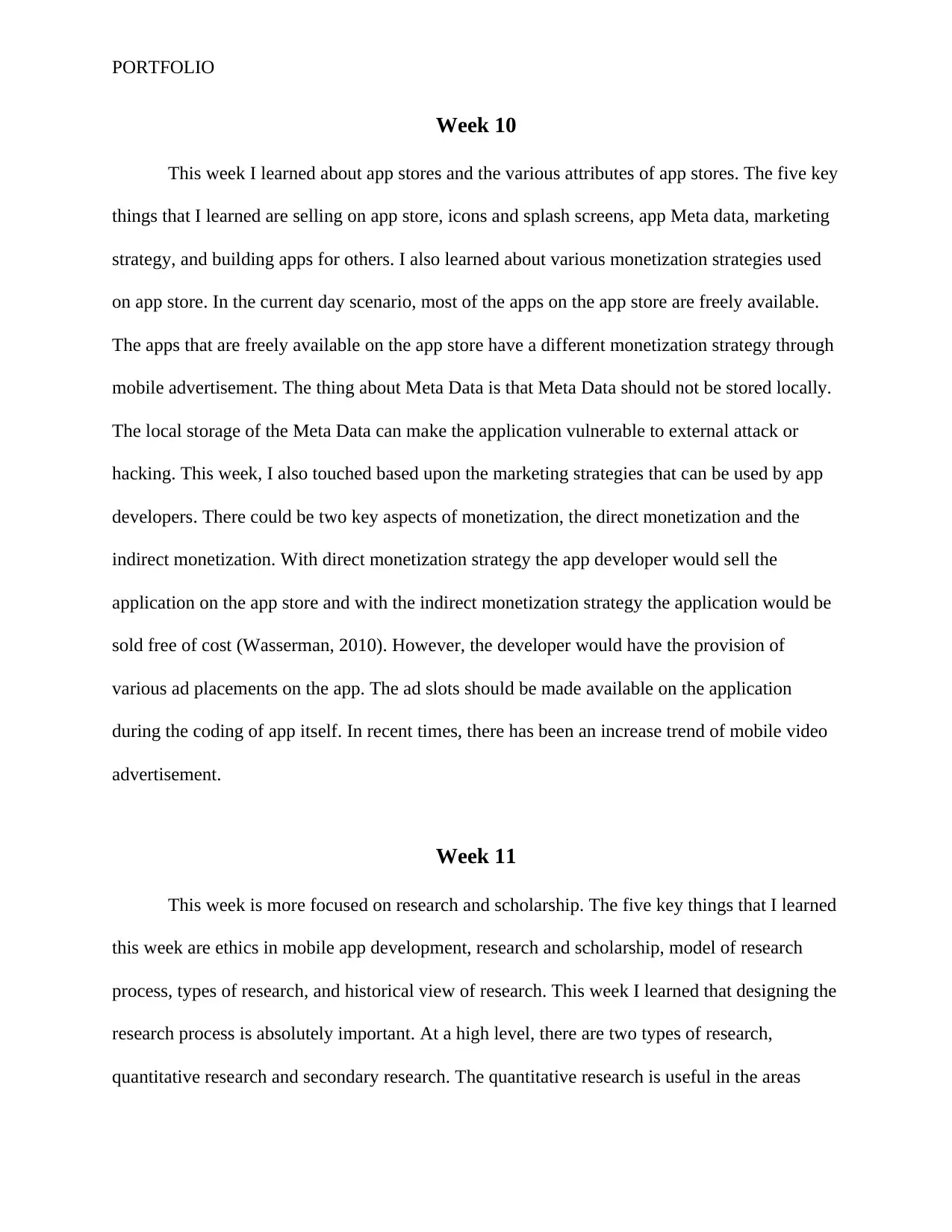
PORTFOLIO
Week 10
This week I learned about app stores and the various attributes of app stores. The five key
things that I learned are selling on app store, icons and splash screens, app Meta data, marketing
strategy, and building apps for others. I also learned about various monetization strategies used
on app store. In the current day scenario, most of the apps on the app store are freely available.
The apps that are freely available on the app store have a different monetization strategy through
mobile advertisement. The thing about Meta Data is that Meta Data should not be stored locally.
The local storage of the Meta Data can make the application vulnerable to external attack or
hacking. This week, I also touched based upon the marketing strategies that can be used by app
developers. There could be two key aspects of monetization, the direct monetization and the
indirect monetization. With direct monetization strategy the app developer would sell the
application on the app store and with the indirect monetization strategy the application would be
sold free of cost (Wasserman, 2010). However, the developer would have the provision of
various ad placements on the app. The ad slots should be made available on the application
during the coding of app itself. In recent times, there has been an increase trend of mobile video
advertisement.
Week 11
This week is more focused on research and scholarship. The five key things that I learned
this week are ethics in mobile app development, research and scholarship, model of research
process, types of research, and historical view of research. This week I learned that designing the
research process is absolutely important. At a high level, there are two types of research,
quantitative research and secondary research. The quantitative research is useful in the areas
Week 10
This week I learned about app stores and the various attributes of app stores. The five key
things that I learned are selling on app store, icons and splash screens, app Meta data, marketing
strategy, and building apps for others. I also learned about various monetization strategies used
on app store. In the current day scenario, most of the apps on the app store are freely available.
The apps that are freely available on the app store have a different monetization strategy through
mobile advertisement. The thing about Meta Data is that Meta Data should not be stored locally.
The local storage of the Meta Data can make the application vulnerable to external attack or
hacking. This week, I also touched based upon the marketing strategies that can be used by app
developers. There could be two key aspects of monetization, the direct monetization and the
indirect monetization. With direct monetization strategy the app developer would sell the
application on the app store and with the indirect monetization strategy the application would be
sold free of cost (Wasserman, 2010). However, the developer would have the provision of
various ad placements on the app. The ad slots should be made available on the application
during the coding of app itself. In recent times, there has been an increase trend of mobile video
advertisement.
Week 11
This week is more focused on research and scholarship. The five key things that I learned
this week are ethics in mobile app development, research and scholarship, model of research
process, types of research, and historical view of research. This week I learned that designing the
research process is absolutely important. At a high level, there are two types of research,
quantitative research and secondary research. The quantitative research is useful in the areas
⊘ This is a preview!⊘
Do you want full access?
Subscribe today to unlock all pages.

Trusted by 1+ million students worldwide
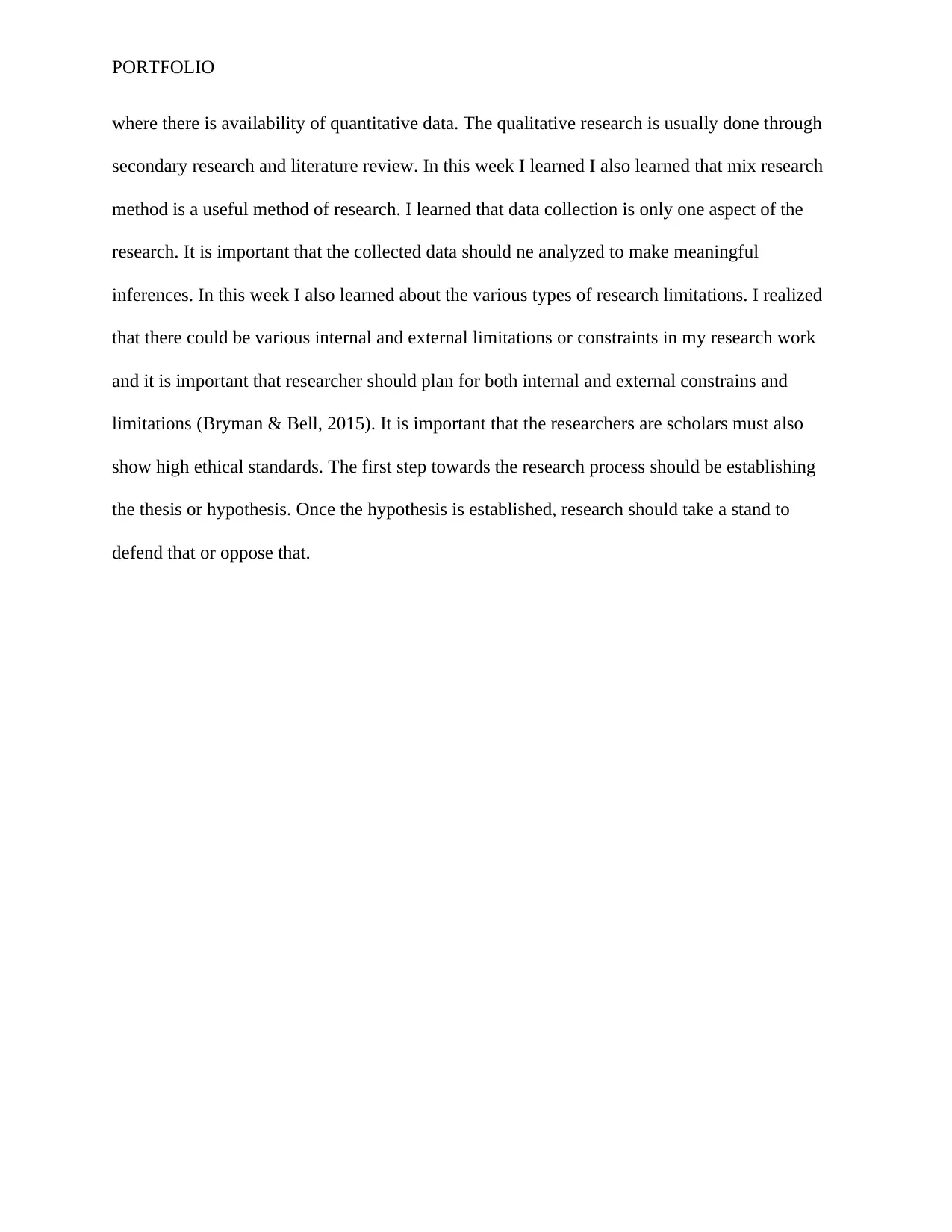
PORTFOLIO
where there is availability of quantitative data. The qualitative research is usually done through
secondary research and literature review. In this week I learned I also learned that mix research
method is a useful method of research. I learned that data collection is only one aspect of the
research. It is important that the collected data should ne analyzed to make meaningful
inferences. In this week I also learned about the various types of research limitations. I realized
that there could be various internal and external limitations or constraints in my research work
and it is important that researcher should plan for both internal and external constrains and
limitations (Bryman & Bell, 2015). It is important that the researchers are scholars must also
show high ethical standards. The first step towards the research process should be establishing
the thesis or hypothesis. Once the hypothesis is established, research should take a stand to
defend that or oppose that.
where there is availability of quantitative data. The qualitative research is usually done through
secondary research and literature review. In this week I learned I also learned that mix research
method is a useful method of research. I learned that data collection is only one aspect of the
research. It is important that the collected data should ne analyzed to make meaningful
inferences. In this week I also learned about the various types of research limitations. I realized
that there could be various internal and external limitations or constraints in my research work
and it is important that researcher should plan for both internal and external constrains and
limitations (Bryman & Bell, 2015). It is important that the researchers are scholars must also
show high ethical standards. The first step towards the research process should be establishing
the thesis or hypothesis. Once the hypothesis is established, research should take a stand to
defend that or oppose that.
Paraphrase This Document
Need a fresh take? Get an instant paraphrase of this document with our AI Paraphraser
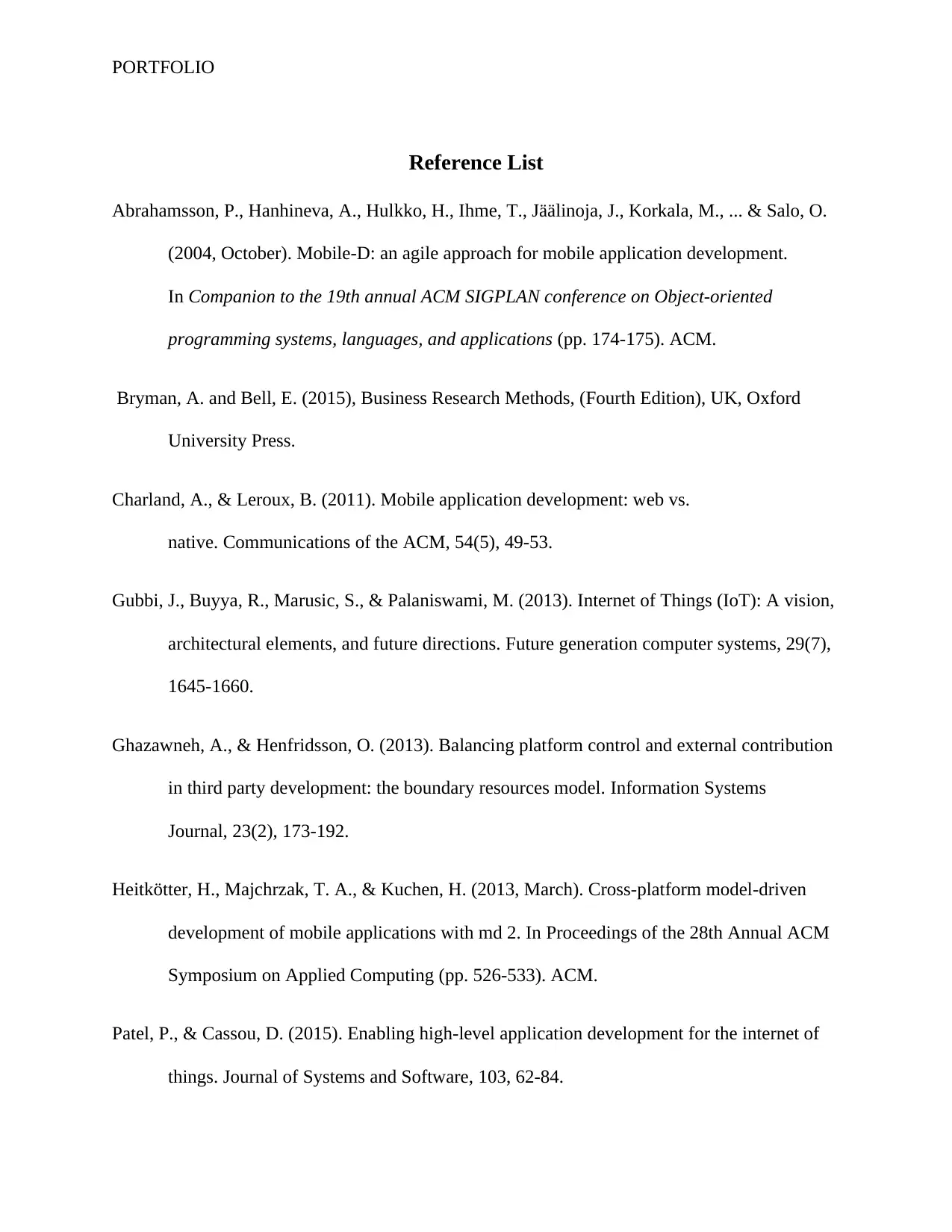
PORTFOLIO
Reference List
Abrahamsson, P., Hanhineva, A., Hulkko, H., Ihme, T., Jäälinoja, J., Korkala, M., ... & Salo, O.
(2004, October). Mobile-D: an agile approach for mobile application development.
In Companion to the 19th annual ACM SIGPLAN conference on Object-oriented
programming systems, languages, and applications (pp. 174-175). ACM.
Bryman, A. and Bell, E. (2015), Business Research Methods, (Fourth Edition), UK, Oxford
University Press.
Charland, A., & Leroux, B. (2011). Mobile application development: web vs.
native. Communications of the ACM, 54(5), 49-53.
Gubbi, J., Buyya, R., Marusic, S., & Palaniswami, M. (2013). Internet of Things (IoT): A vision,
architectural elements, and future directions. Future generation computer systems, 29(7),
1645-1660.
Ghazawneh, A., & Henfridsson, O. (2013). Balancing platform control and external contribution
in third party development: the boundary resources model. Information Systems
Journal, 23(2), 173-192.
Heitkötter, H., Majchrzak, T. A., & Kuchen, H. (2013, March). Cross-platform model-driven
development of mobile applications with md 2. In Proceedings of the 28th Annual ACM
Symposium on Applied Computing (pp. 526-533). ACM.
Patel, P., & Cassou, D. (2015). Enabling high-level application development for the internet of
things. Journal of Systems and Software, 103, 62-84.
Reference List
Abrahamsson, P., Hanhineva, A., Hulkko, H., Ihme, T., Jäälinoja, J., Korkala, M., ... & Salo, O.
(2004, October). Mobile-D: an agile approach for mobile application development.
In Companion to the 19th annual ACM SIGPLAN conference on Object-oriented
programming systems, languages, and applications (pp. 174-175). ACM.
Bryman, A. and Bell, E. (2015), Business Research Methods, (Fourth Edition), UK, Oxford
University Press.
Charland, A., & Leroux, B. (2011). Mobile application development: web vs.
native. Communications of the ACM, 54(5), 49-53.
Gubbi, J., Buyya, R., Marusic, S., & Palaniswami, M. (2013). Internet of Things (IoT): A vision,
architectural elements, and future directions. Future generation computer systems, 29(7),
1645-1660.
Ghazawneh, A., & Henfridsson, O. (2013). Balancing platform control and external contribution
in third party development: the boundary resources model. Information Systems
Journal, 23(2), 173-192.
Heitkötter, H., Majchrzak, T. A., & Kuchen, H. (2013, March). Cross-platform model-driven
development of mobile applications with md 2. In Proceedings of the 28th Annual ACM
Symposium on Applied Computing (pp. 526-533). ACM.
Patel, P., & Cassou, D. (2015). Enabling high-level application development for the internet of
things. Journal of Systems and Software, 103, 62-84.
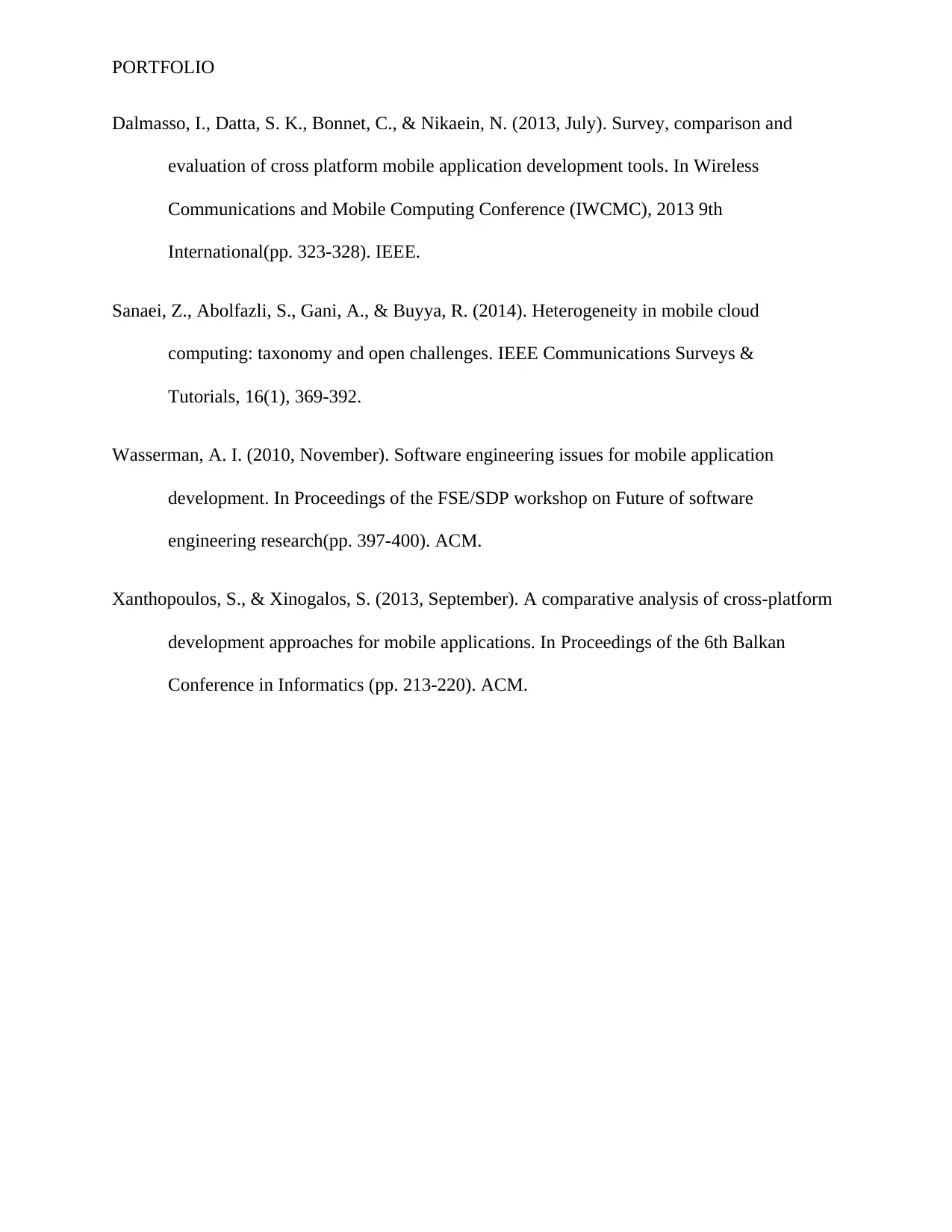
PORTFOLIO
Dalmasso, I., Datta, S. K., Bonnet, C., & Nikaein, N. (2013, July). Survey, comparison and
evaluation of cross platform mobile application development tools. In Wireless
Communications and Mobile Computing Conference (IWCMC), 2013 9th
International(pp. 323-328). IEEE.
Sanaei, Z., Abolfazli, S., Gani, A., & Buyya, R. (2014). Heterogeneity in mobile cloud
computing: taxonomy and open challenges. IEEE Communications Surveys &
Tutorials, 16(1), 369-392.
Wasserman, A. I. (2010, November). Software engineering issues for mobile application
development. In Proceedings of the FSE/SDP workshop on Future of software
engineering research(pp. 397-400). ACM.
Xanthopoulos, S., & Xinogalos, S. (2013, September). A comparative analysis of cross-platform
development approaches for mobile applications. In Proceedings of the 6th Balkan
Conference in Informatics (pp. 213-220). ACM.
Dalmasso, I., Datta, S. K., Bonnet, C., & Nikaein, N. (2013, July). Survey, comparison and
evaluation of cross platform mobile application development tools. In Wireless
Communications and Mobile Computing Conference (IWCMC), 2013 9th
International(pp. 323-328). IEEE.
Sanaei, Z., Abolfazli, S., Gani, A., & Buyya, R. (2014). Heterogeneity in mobile cloud
computing: taxonomy and open challenges. IEEE Communications Surveys &
Tutorials, 16(1), 369-392.
Wasserman, A. I. (2010, November). Software engineering issues for mobile application
development. In Proceedings of the FSE/SDP workshop on Future of software
engineering research(pp. 397-400). ACM.
Xanthopoulos, S., & Xinogalos, S. (2013, September). A comparative analysis of cross-platform
development approaches for mobile applications. In Proceedings of the 6th Balkan
Conference in Informatics (pp. 213-220). ACM.
⊘ This is a preview!⊘
Do you want full access?
Subscribe today to unlock all pages.

Trusted by 1+ million students worldwide
1 out of 12
Related Documents
Your All-in-One AI-Powered Toolkit for Academic Success.
+13062052269
info@desklib.com
Available 24*7 on WhatsApp / Email
![[object Object]](/_next/static/media/star-bottom.7253800d.svg)
Unlock your academic potential
Copyright © 2020–2025 A2Z Services. All Rights Reserved. Developed and managed by ZUCOL.




